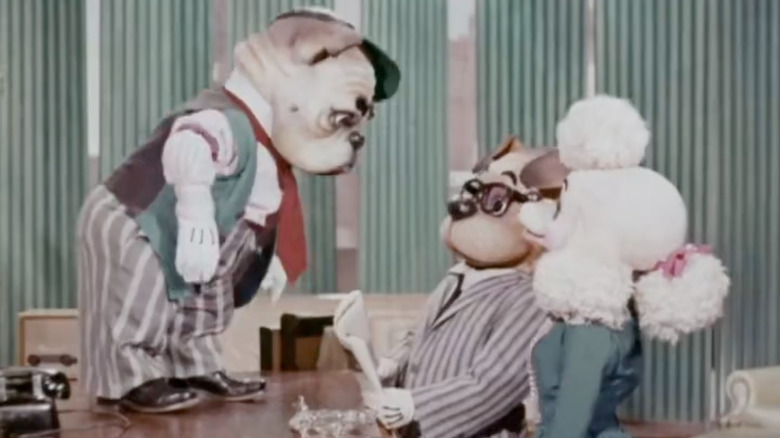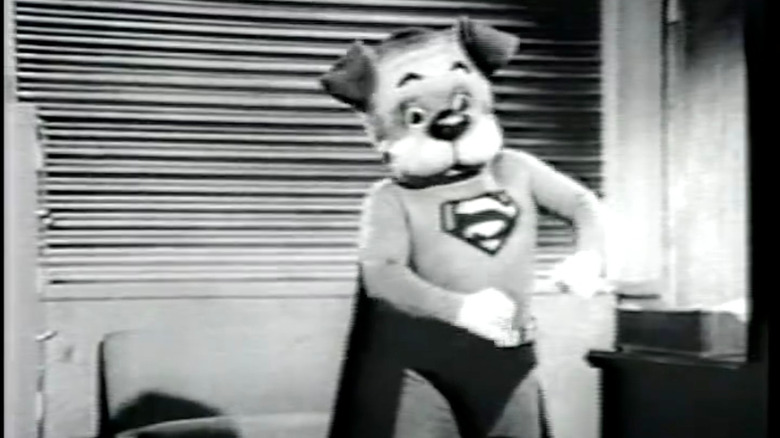The Bizarre Unaired Superman Pilot You Probably Didn't Know About
Long before Christopher Reeve showed audiences that a man could fly, the cinematic legacy of Superman had already gotten a jump start from all forms of media. The strikingly fluid animation of the early '40s Max Fleischer cartoons made it feel as if you were watching an issue of "Superman" come to life. They were impressive feats for the time and, even today, still look pretty phenomenal, capturing the weight and scale of a powerful superhero living among the people. Later that same decade, Superman's first live-action appearances on the big screen arrived in the form of two serials ("Superman" and "Atom Man Vs. Superman"). Kirk Alyn, who largely went uncredited as the titular superhero, may have become an animated figure when it came to flying, but on the ground, people got to see an actual person in the suit. It would be two years after Alyn's last appearance as the Man of Steel, however, when another actor would take over the mantle for most of the following decade.
Not only does George Reeves hold the distinction of starring in the first "Superman" feature, but the first DC Comics movie with "Superman and the Mole Men." Through a contemporary lens, it's little more than an undercooked backdoor pilot for the television series that's not much of a comic book movie, running at just 58 minutes in length. Although there is an admirable attempt to address the harmful process of "othering" individuals we don't understand, confused radioactive mole men from beneath the surface in this case. A large reason why the film works is that Reeves was a good actor who managed to showcase Superman's inherently kind nature in the face of bigotry. He even goes so far as comparing the actions of the hate-fueled mob to those of Nazi stormtroopers
While "Mole Men" may not have worked as a feature film, there was no doubt that Reeves was the face of Superman, leading into the "Adventures of Superman" television show that ran on ABC from 1952 to 1958. For six seasons, Reeves upheld the idealism of a superbeing who stood for doing the right thing. He had such a sly charm about him that always made his presence feel super, even when he wasn't doing super things. To younger audiences, Reeves might as well have been the actual Superman. Before Reeves' unfortunate passing in 1959, it was up in the air as to whether the "Adventures of Superman" would return for a seventh season. It was in the interim that series co-creator Whitney Ellsworth and animator Cal Howard sought to form a spin-off series that skewed towards even younger audiences, and "The Adventures of Super Pup" is even stranger than you're anticipating.
The Adventures of Super Pup takes a canine approach to the Man of Steel
Have you ever imagined what the "Adventures of Superman" would be like if every character were envisioned as animals? Well, thanks to the bizarre pilot of "The Adventures of Super Pup," you can! Shot on a lot of the same sets as the hit ABC series, "Super Pup" transforms the show's ensemble into a bunch of anthropomorphized animals, with our main hero secretly moonlighting as star reporter Bark Bent (Billy Curtis). The rest of the ensemble are pun-inspired riffs (or ruffs) on their DC counterparts. Lois Lane is represented as Pamela Poodle (Ruth Delfino), and Perry White is a bulldog named Terry Bite (Angelo Rossito), while Jimmy Olsen is a rodent puppet that lives out of Bark's desk named Montgomery Mouse (Sadie Delfino). The latter is more akin to Super Pup's Jiminy Cricket than anything else. It's no longer the Daily Planet they all work out of, but the Daily Bugle. It bears no relationship to the newspaper found in the "Spider-Man" comics over at Marvel, pre-dating the web-slinger by at least a few years.
Rather than moving forward with an animated series that would better suit this idea, "Super Pup" instead opted to hire little people who would have to wear these bulking mascot heads over their bodies. It was a crapshoot as to whether the mouths would actually move when the characters spoke from within these cheaply constructed costumes. No one really knows where to stand or look, often making the set look like a free-for-all in terms of direction. It's notable that Super Pup was played by someone who was already a DC alum, with Curtis having played one of the titular antagonists in "Superman and the Mole Men" earlier in the decade.
In comparison to Reeves, Curtis' Super Pup performs the bare minimum of a superhero in saving his journalistic co-workers, but not really possessing much of a personality. There's only one cheeky moment where Bark Bent accidentally takes credit for performing a rescue that Super Pup did, nearly revealing his secret identity. It doesn't really matter though, as Curtis plays both shades of the character in the exact same way.
Considering "Super Pup" never actually made it to air, most people have never even seen the failed spin-off. I first remember seeing clips of it in the 2006 documentary "Look, Up in the Sky! The Amazing Story of Superman," and only saw the entire thing as a bonus feature in the 2011 "Superman Anthology" Blu-ray set. The first half of the episode is from a surviving color print, while the back half is from a black-and-white video master. The garbled audio, coupled with the bizarre costumes, would make it feel right at home as a cursed artifact in the "Skinamarink" house.
The unaired pilot remains a DC television oddity
From a tonal perspective, "Super Pup" fits more in line with what would become the 1966 "Batman" television series, which lampooned its lead superhero through a number of cartoonish gags. It doesn't seek to take itself remotely seriously, nor does it even attempt to capture the tone of the Reeves series. Whenever Super Pup arrives on the scene to perform a rescue, he's accompanied by the William Tell Overture instead of any kind of exciting superhero music. The show is a big goof seeking to entertain an even younger demographic, and it shows.
The villain of the week is Professor Sheepdip (Harry Monty), a sheepdog who literally attempts to escape his jail cell using an actual saw. The bumbling Sergeant Beagle (Frank Delfino) doesn't notice this or Prof. Sheepdip's goofy sidekick Wolfingham (also Sadie Delfin) breaking him out through the front door. The mad (dog) scientist plots to blow up the Daily Bugle for publishing an article about his capture by Trojan-horsing a bomb within a grandfather clock inside the building. Wolfingham moves about it in the same manner as the toys in "Toy Story 2" walk around in the orange construction cones. When Super Pup foils the evil master plan, Prof. Sheepdip refers to the time-honored tradition of capturing Lois La-errr I mean, Pamela Poodle by strapping her to a rocket.
Even though "Super Pup" isn't a very good pilot, I found myself laughing here and there at the sheer absurdity of this thing being put together. What really got me were a lot of the sight gags, intended or otherwise. Right below the Daily Planet headline "Prof. Sheepdip In Jail" is a subheader that reads "Chicago Blast Kills Twelve," which seems kind of intense for a kids' show. There's also a funny moment when the mad professor dips a paper plane in some toxic chemical and tosses it out the window, followed by stock footage of an atomic bomb going off.
It's hard to fully lambast "Super Pup" for feeling weird and unfinished, considering it never even got the chance to see if it would have actually been improved in future episodes. You know it's incomplete because the pilot is bookended by the narrator saying,g "your product, the best in the world, presents 'The Adventures of Super Pup.'" I can only wonder which company would have stepped up to sponsor the strange little series in the same way that Kellogg's cereal backed up the "Adventures of Superman."
Plenty of DC projects have leaned more towards pet-friendly properties, such as the 2005 "Krypto" animated series and the 2022 "DC League of Super Pets" feature film. There's a market out there for animal-driven incarnations of the DC properties, but "Super Pup" is such an oddity in the pantheon of comic book adaptations that the 21-minute pilot kind of has to be seen to be believed.


